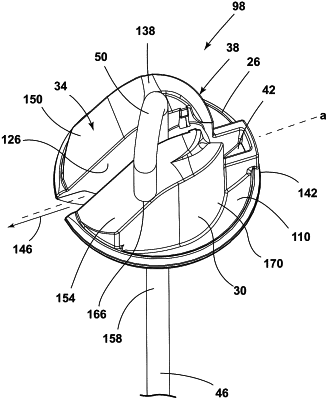| CPC D06F 37/24 (2013.01) [D06F 37/268 (2013.01); F16C 11/06 (2013.01); F16C 11/0614 (2013.01)] | 20 Claims |

|
1. A suspension system for a laundry appliance, comprising:
a bracket configured to couple to a cabinet frame, wherein the bracket defines a depression and a receiving aperture within the depression;
a suspension support including:
a base selectively positioned in the depression; and
an engagement portion coupled to the base, wherein the engagement portion has at least one ejection portion having an ejection surface and at least one assembling portion having an assembling surface; and
a suspension rod having a linear portion and a hook with an end, wherein the end of the hook is configured to engage the engagement portion when misaligned to slide in a first direction on the assembling surface along a retaining movement path to an installed position or in a second direction on the ejection surface along a disengaging exit movement path to disengage from the suspension support, and wherein a width of space between the linear portion and the end of the hook is less than each of a minimum thickness of the at least one ejection portion between an inner surface of a central channel and an outer surface and a minimum thickness of the at least one assembling portion between the inner surface of the central channel and the outer surface to promote a sliding engagement between the hook and the suspension support, and further wherein the suspension rod is configured to travel along the retaining movement path to the installed position when the end of the hook engages the at least one assembling surface and along the disengaging exit movement path when the end of the hook engages the at least one ejection surface.
|